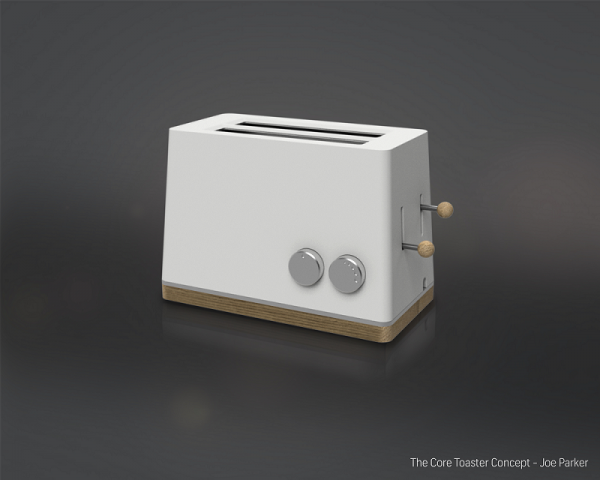The Core Toaster has been designed to combat the lack of longevity and reparability in small kitchen appliances, and enhance the aesthetic longevity of the product through quality materials selection. The intention of the design is to encourage users to better maintain their toasters for longer life and sustainability.
Autodesk Software Used:
Project Challenge
From the onset, the project was focused on promoting the toaster with a sense of emotional durability (designing things we would cherish and keep, rather than throw away) alongside traditional streamlining of internal components and longevity. The designer, Joe, wanted the design to appeal to its user long after purchase, so that if something were to fail within the assembly, the user would be inclined to repair it as opposed to replacing it entirely. The intention was to produce not only a more sustainable appliance through careful materials selection and fabrication processes, but also encourage users to care for the toaster on a daily basis. For example, frequent cleaning, maintenance and eventual replacement of components. By making the appliance more desirable and delicate (due to cast ceramic body) it would reinforce the idea of a tactile and attractive product, so users would be more inclined to look after it.
The students were tasked with a one-day exercise requiring the disassembly of a cheap toaster or kettle, and imagining improvements to the design of the product. For further information, please find educator Jamie Billings’ blog on the project.
Project Outcomes - Benefits of Using Sustainability Workshop and Autodesk Software
The Sustainability Workshop provided a quick and easy introduction to a wide range of sustainability concepts and design consideration worth implementing into any design project. The videos and reference guides provide useful information in the areas in which sustainability gains can be made - from the raw materials selection, manufacturing of the item, and the end-of-life decisions to consider (i.e. recyclability reparability and remanufacture etc)- all of which can have an impact on a product’s sustainability, longevity and design decisions.
Design Process & Tools
With the availability of the Sustainability Workshop’s reference guides and videos, Joe was able to go through the design process and critically analyse potential areas of concern which may arise in the future longevity or repair of the product. Alongside extensive amounts of sketches and notes, several test models and research was undertaken to ensure the toaster would have succeeded at being easy to repair and maintain.
The use of Fusion 360 enabled Joe to make quick and easy modifications to CAD models and visualise materials combinations prior to the final model outcome. Fusion 360 provided a user-friendly, effective and powerful CAD tool, which allowed Joe to consider how the toaster could be maintained and assembled sustainably, and also use the same models for visual renderings of various materials along with CNC outputs for models and prototypes of components.
Summary
The Sustainability Workshop guides can be applied to all design projects and help provide the framework for sustainable design thinking from the onset of a design project to ensure more efficient and environmentally sustainable products reach consumers. Applying these videos and guides to decision making throughout the creative process helps ensure the success of a products reparability or recyclability rather than desperately trying to retrofit these considerations toward the end of design. By using Fusion 360 Joe was able to create detailed CAD models and subsequent renders to help inform and refine the final design of both the aesthetic appearance of the toaster but more importantly how the internal components would be assembled.
Conclusions
Later research amongst test consumers suggested many were more comfortable repairing and maintaining the core toaster with its lack of screws and accessibility over current toasters with their heavy reliance of irreplaceable components or difficult-to-clean internals. Those asked also said they felt more inclined to maintain the toaster as its use of premium materials and considered aesthetic made it a more desirable unit to keep over the typical white plastic bodied toasters which are often discarded when visible signs of wear become apparent.
For more information on the toaster, please click here.
To view a video on the project here.


